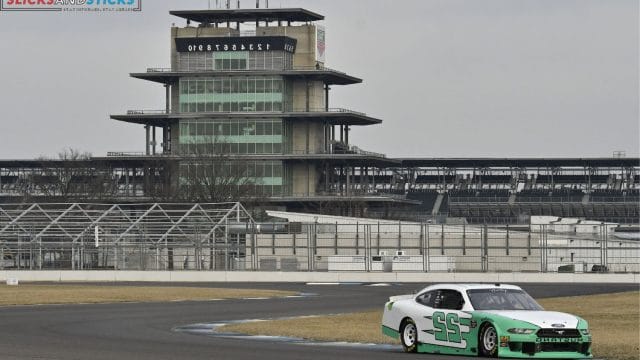Indianapolis Road Course Dilemma: The Indianapolis Road Course has presented a mixed bag of racing experiences. Michael McDowell and Front Row Motorsports won the 2023 season despite several hurdles. This qualified them for NASCAR Playoffs. The race was decent but not great. The event was fun, but NASCAR’s rich history will not remember it.
Some Indianapolis Motor Speedway fans think the 2.5-mile oval track hasn’t always produced spectacular races. The field would spread out around the rectangular track and count laps without any racing.
Why use the road course if it doesn’t provide thrilling races? The IMS Circle is known as one of the world’s top racetracks. If NASCAR’s Cup Series comes here, it should be because of its rich heritage.
Racing on road courses and minor tracks began with the Gen-6 vehicle. The Next Generation (Gen-7) has improved racing in several locales. The most famous track in America, IMS, should host the biggest race.
Michael said the road track at Indy was necessary because the old Cup cars struggled on the oval. NASCAR should return to flat tracks or eliminate Indy after releasing the new Cup vehicle. Some road courses are better than the Indy, which has no hills or sharp curves and only average racing.
Shane van Gisbergen’s victory on the Chicago street track was influenced by the weather and unfamiliarity with the course. These things will be irrelevant if he moves to the US permanently. Even though he’s 34, which is elderly for a race car driver to transition to road racing, he could be a strong candidate for a squad that wants to win the title.
Van Gisbergen may be good or horrible on NASCAR oval tracks, but road courses are dangerous. He may adapt to oval circuits better than Ambrose because he has driven V-8 Supercars and dirt tracks.
Richard is unsure if more NASCAR and IndyCar weekends can be held together. The notion seems good, but broadcast rights, garage space, ticket packages, and media access are difficult. The only location that could work is Indianapolis Motor Speedway.

Michael believes that since Roger Penske runs the IndyCar Series, NASCAR will likely partner with them. The Charlotte Roval might host IndyCar and NASCAR races on the same day. Since the IndyCar race is in NASCAR territory, attendance is questionable. Putting the Nashville IndyCar race after the Bristol night race would be a “doubleheader,” but we’re not sure if it’s a good idea.
Ultimately, the debate about the Indianapolis Road Course, Shane van Gisbergen’s potential triumph in NASCAR, and the chance of having more NASCAR and IndyCar races on the same weekend indicate numerous factors to consider. The decisions made in these areas will determine the future of American motorsport. It’s important to balance sticking to old ways, exploring new ideas, and striving for thrilling races.
READ MORE: NASCAR 2024 Season: Austin Hill’s Signing, Olympic Rumors, and Stewart-Haas Racing’s Future
Our Reader’s Queries
Why does NASCAR run the road course at Indy?
In an effort to simplify their event weekends, NASCAR and IndyCar teamed up to hold a joint race weekend at the same track. This marked the first time that both Cup and Xfinity races were held on the road course, while IndyCar also joined in on the action. This successful collaboration continued for the next three years, culminating in a historic tripleheader weekend that took place entirely on IMS’s road course.
How fast can a NASCAR go without restrictor plates?
On specific tracks, a NASCAR vehicle can exceed 200 miles per hour without restrictor plates. The actual speed may fluctuate based on various factors, including track length, banking, and other conditions.
What is the Indianapolis Motor Speedway Safer Barrier?
The SAFER barrier, a safety innovation for race tracks, was created between 1998 and 2002. It was first put into action at the Indianapolis Motor Speedway in May 2002. The barrier is made up of structural steel tubes that are welded together and mounted flush against the existing concrete retaining wall. This design ensures maximum protection for drivers in the event of a crash.
Is NASCAR louder than Formula 1?
NASCAR enthusiasts can breathe a sigh of relief as they are only subjected to 100-dB of noise, akin to the sound of a lawnmower. While NASCAR may not be the most ear-splitting racing event, Drag Racing takes the cake with a whopping 150 dB, followed by Formula 1 at 145 dB. IndyCar racing matches NASCAR’s noise level at 130 dB.
